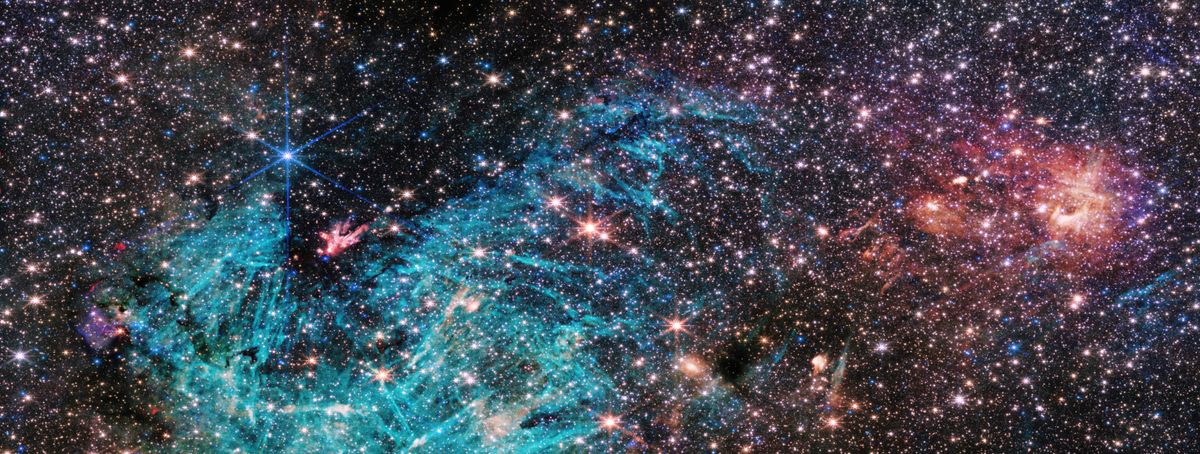A special group of stars orbiting the violent center of the Milky Way could become “immortal” by constantly capturing and destroying dark matter particles in their cores, a new study suggests.
Using computer simulations of stellar evolution, the researchers found that dark matter particles captured by the gravity of these stars can often collide and “annihilate” each other inside the star, turning into ordinary particles releasing a significant amount of energy.
This additional energy source could maintain the star’s stability and potentially make it immortal, even after its regular supply of nuclear fuel has run out, the researchers suggest.
“Stars burn hydrogen nuclear fusion“, the main author of the study Isabelle John, a doctoral candidate in astroparticle physics at Stockholm University, told Live Science via email. “The outward pressure from this balances the inward pressure from gravitational forces and keeps the stars in a stable equilibrium.”
However, many stars observed near the Milky Way’s central black hole appear to be much younger than theories of stellar evolution predict. To investigate this mystery, the researchers tested whether stars could draw energy from the abundant supply of dark matter thought to exist in the galactic center.
“Our simulations show that if stars can collect large amounts of dark matter, which is annihilated inside the star, this can provide a similar pressure on the outside, making the star stable due to the annihilation of dark matter rather than nuclear fusion – so stars can use dark matter as a fuel instead of hydrogen,” John said. “The important difference is that stars use their own hydrogen, which will eventually cause them to die. On the other hand, stars can continuously collect dark matter.”
study, published on the arXiv preprint server in May, has not yet been peer-reviewed.
Stars that defy theory

Stellar evolution is a well-studied topic. The relationships between a star’s age, luminosity, size, and temperature have been derived with high precision from both theory and astronomical data. However, recent observations have shown that the properties of stars near the center of Milky Way contradict the generally accepted theory of stellar evolution.
Connected: Small stars that defy explanation are ‘swallowing like bees’ around the Milky Way’s supermassive black hole
“The innermost stars of our galaxy, the S-group stars, show a number of features that [are] found nowhere else: It’s not clear how they got so close to the center, where the environment is thought to be quite hostile to star formation,” John explained. “They also appear to be much younger than would be expected if the stars had moved there from somewhere else. What’s more, it seems like there are suddenly a lot of heavy stars.”
These strange properties of S-group stars can be explained by the presence of an additional source of energy inside them. For example, this extra energy source could allow the star to burn hydrogen—the usual energy source—at a slower rate, causing it to age more slowly and appear younger than it actually is. .
In their latest study, John, along with Tim Linden of Stockholm University and Rebecca K. Leane of the SLAC National Accelerator Laboratory at Stanford University, suggested that this source may be the annihilation of dark matter particles. This explanation is consistent with the fact that larger amounts of dark matter are believed to lurk in the center of the galaxy, precisely where the strange stars were observed.
“In most of the Milky Way, the density of dark matter is not high enough to affect the stars,” John said. “But in the Galactic Center, the amount of dark matter is very high, potentially many billions of times higher than on Earth.”
Virtual annihilation
To test their hypothesis, the researchers performed a computer simulation of the life cycle of a star surrounded by a cloud of dark matter with a density matching that of the galactic center. They hypothesized that dark matter consists of weakly interacting massive particles, one of the leading candidates for the components of dark matter.
Since dark matter particles have not yet been found in laboratory experiments, the strength of their interaction with ordinary matter and the rate at which they annihilate each other are unknown. But the study showed that for certain values of these quantities, the energy production mechanism based on dark matter perfectly explained the observed properties of S-group stars.
However, to confirm their explanation, the authors believe that more stars should be discovered near the galactic center. Furthermore, more precise measurements of known stellar parameters must be performed to reliably compare observations with theoretical predictions. Hopefully, such observations will be possible in the near future using the Very Large Telescope in Chile or the Keck Observatory in Hawaii, the researchers said.
“More precise observations of S-group stars will give us more information about these stars and their ongoing processes,” John said. “This will show whether the observations are consistent with our simulations, or whether other explanations for their unusual properties become more favorable.”